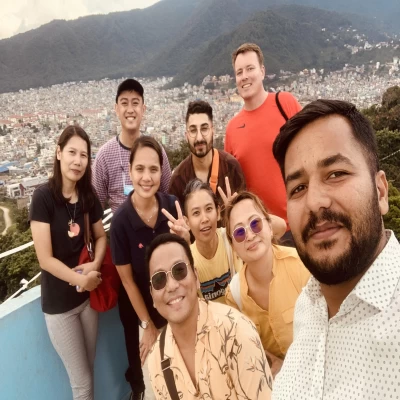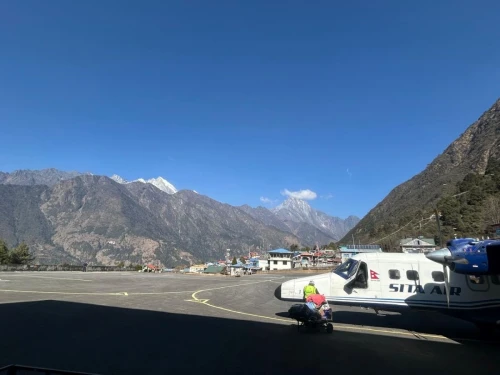What is Kanchenjunga Circuit Trekking?
Kanchenjunga Circuit Trekking is a wonderful nature experience in remote Nepal that takes you to the base camp of Mount Kanchenjunga. This trek is 18 days long and goes through lovely valleys, dense forests, tall mountains, and villages with old-fashioned touches.
The journey is not as crowded compared to other treks like Everest Base Camp Trek or Annapurna Circuit Trek. This makes the trek relaxing and somewhat challenging as well. The tourists can expect the trails to become rocky and difficult in certain areas, as well as a high elevation factor that keeps you trekking almost all day. It is a satisfying trek of nature and adventure, so start with some more details on what lies ahead.
Physical Fitness Requirements for Kanchenjunga Circuit Trekking
The Kanchenjunga Circuit Trek is a longer and remote journey in Nepal, so it’s important to be in good physical shape. You don’t need to be an athlete, but you should be comfortable walking for several hours a day with a pack on. A bit of training before the journey can make your trip much easier and more pleasurable.
These are the types of physical activity you'll require
- Cardiovascular endurance: Do cardio or jog 5 to 7 hours every day, sometimes uphill, at a steady pace.
- Leg strength: Do leg exercises because strong legs prevent you from tiring too much during steep climbs or long descents.
- Core strength: A strong core allows balance and carrying a backpack.
- Stamina: The trip stretches for over 2 weeks, so one must sustain their energy every day.
- Mental strength: A positive attitude and motivation are, quite often, just as important as physical training.
Here are some easy tips for preparing before the trek:
- Join or lead many hikes with a light pack.
- Keep on walking, jogging, or cycling most days of the week before the trek.
- Climb or use stairs as practice.
- Load a daypack with some weight.
- Stretch out or practice yoga for adaptability and to prevent injury.
You don’t have to be super fit to complete the Kanchenjunga Circuit Trek, but being physically and mentally fit will make the trip much more pleasurable. Start training many weeks( or months) ahead, and you’ll thank yourself on the trail!
Terrain and Trail Conditions of Kanchenjunga Circuit Trek
The trail conditions on the Kanchenjunga Circuit Trek can be very difficult, especially for those who are inexperienced. The trekking trails here are remote and less crowded than those to Everest or Annapurna, that's they are not as well-maintained. You would be trekking on paths which are filled with rocks, steep uphill and slippery downhill sections, narrow trails, and at times even areas affected by landslides.
The majority of the sections of the trek go through the thick forests, and the parts that are left cross the high alpine zones and are at the foot of glacier moraines. One should be careful about long walking days on uneven surfaces. The scenery during the trekking route is beautiful; however, the path surely requires a good level of fitness, endurance, and caution while stepping. If it is necessary to face the difficult parts or the places where the signboard is not clear, then having a guide can make everything much easier.
Altitude and Acclimatization Challenges During the Kanchenjunga Trek
The Kanchenjunga Circuit Trek is very high in altitude, which is above 5,000 meters. Trekking higher means there is less air to breathe and more chances of altitude sickness if one fails to heed caution. Hence, this is a great issue for a beginner who has not faced the pain of being at such a height before. If any symptoms like headache, dizziness, nausea, or shortness of breath are seen, then trouble may be near. This is because your body is not well acclimatized to the environment. So, for Kanchenjunga, keeping time for acclimatization or adjustment during trekking should be taken into consideration.
Trekkers should correctly shape their itinerary with necessary rest days at certain altitudes rather than speeding through. A little knowledge about altitude sicknesses and the problems that could arise, along with ways to avoid them or treat them, should be a guarantee for a much more pleasant and safe trek for you.
The Kanchenjunga Trek goes farther up into high altitudes, with its highest points reaching more than 5,000 meters. Up higher, the air thins, making it harder to breathe, and the risk of altitude sickness increases unless one is cautious about it. Altitude sickness constitutes one of the hardest problems for trekkers, especially for those not used to such heights.
The onset of symptoms such as headache, dizziness, nausea, or shortness of breath means that the body has poorly adapted itself. Therefore, acclimatization time generally goes into your considerations during any Kanchenjunga trek. Never rush through it, but take your proper schedule with rest days at specified altitudes. Knowing some altitude-related troubles and their prevention or remedy will make this task much safer and enjoyable.
Simple Tips for Managing Altitude Sickness:
- Ascend slowly and never skip acclimatization days
- Intake an adequate amount of water and avoid alcoholic and caffeinated beverages
- Eat well for energy
- Rest adequately if symptoms commence
- Consider taking medications such as Diamox (only after doctor's advice)
- Immediately descend if symptoms worsen
- Travel with a guide who understands altitude issues.
Duration and Daily Trekking Hours
The Kanchenjunga Circuit takes around 18 days, including the days for traveling, trekking, and acclimatization. Each day has a different trekking distance and duration, with the early days being easier in order to get your body going, then picking up with challenging days as it goes up.
Most trekking days involve 4 hours to 7 hours of walking and are mixed with rest or acclimatization days to give your body the needed time to adjust to the altitude. The days are planned in such a manner that you get to soak in the glorious sights without rushing.
Here is the daily trekking itinerary and approximate trekking hours of the Kanchenjunga circuit trek:
| Day | Activity | Trekking/Driving
Duration (Approx.) | Notes |
| Day 1 | Fly to Bhadrapur, Drive to
Taplejung | 5-6 hours | Travel day, no
trekking |
| Day 2 | Drive to Sekathum | 6-7 hours | Travel day, no
trekking |
| Day 3 | Trek to Amjilosa | 5-6 hours | Moderate trekking starts |
| Day 4 | Trek to Gyabla | 5-6 hours | Gradual elevation gain |
| Day 5 | Trek to Ghunsa | 5-6 hours | Scenic trail,
moderate effort |
| Day 6 | Acclimatization day at Ghunsa | 2-3 hours | Rest and explore nearby |
| Day 7 | Trek to Kambachen | 6-7 hours | More challenging, uphill |
| Day 8 | Trek to Lhonak | 6-7 hours | Steeper terrain,
higher altitude |
| Day 9 | Hike to Kanchenjunga Base
Camp | 5-6 hours | High altitude, tough hike |
| Day 10 | Trek back to Ghunsa | 5-6 hours | Descending, less
strenuous |
| Day 11 | Trek to Sele La Kharka | 6-7 hours | Steep trails,
challenging day |
| Day 12 | Trek over Sele La Pass to
Tseram | 6-7 hours | Crossing high
mountain pass |
| Day 13 | Trek to Oktang and back to
Ramche | 5-6 hours | Side trip to South
Base Camp |
| Day 14 | Trek back to Tseram | 5-6 hours | Easier descent |
| Day 15 | Trek to Tortong | 5-6 hours | Moderate trail |
| Day 16 | Trek to Yamphudin | 5-6 hours | Final trekking day |
| Day 17 | Drive to Kanyam, Ilam | 4-5 hours | Travel day |
| Day 18 | Drive to Bhadrapur, Fly to
Kathmandu | 5-6 hours | Travel day |
Weather and Seasonal Difficulty for Kanchenjunga Circuit Trek
The weather is a key determinant of the difficulty level of this trek. It will get you high in the mountains, where the weather is highly changeable with respect to the season. And the best time for the Kanchenjunga Circuit Trek in Nepal is in spring (March-May) or autumn (September-November). Generally, this season has clear weather and has a comfortable temperature for trekking and spectacular mountain views, with almost no risk of rain or snow.
However during the rainy season (June-August), the thunder rain makes this trek difficult and extremely difficult to undertake. These rains make the trail slippery and muddy, thus making it a little dangerous to walk. Also, landslides can occur due to heavy rain, or it can block your way through the track so it will certainly not be good for first-timers.
Winter( December to February) is veritably cold, especially at high elevations. Snow can cover the trails, making them slippery and tough to walk on. However, this season will add a redundant challenge if you aren't used to cold-weather trekking.
So, choosing the right season is veritably important to avoid harsh weather and make your Kanchenjunga journey safer and further enjoyable. However, spring and afterlife are the best seasons for Kanchenjunga Circuit Trek, If you want to avoid difficulties caused by weather.
Logistics and Support on the Kanchenjunga Circuit Trail
As Kanchenjunga Circuit Trekking is done in a remote, less-crowded trekking route, organizing your logistics and knowing what kind of support is available is very important.
Here are the basic things you should know to make your trek smoother and safer.
- Accommodation along the route is very basic, like a few tea houses and lodges, which are quite far apart.
- Food on the trek mainly consists of local Nepali meals, so carrying a method to purify water is necessary.
- A guide is highly recommended, given that the trail is remote and often not well marked.
- Porters will be hired to carry heavy bags and ease the trek.
- Trekkers must have special permits such as the Kanchenjunga Conservation Area Permit and a TIMS card.
- Mobile network coverage is very limited or non-existent in many places along the trail.
- Medical facilities are few and are available in a few places, so carrying a good first aid kit and the ability to plan for emergencies is important.
- Traveling to the starting point usually involves some combination of flights and jeep rides being arranged by trekking agencies such as Mount Glory.
In Conclusion
This trek is one of the most difficult and yet rewarding adventures in Nepal. The Kanchenjunga Circuit Trek offers the experienced walker an opportunity for an off-the-beaten-track journey, diverse experiences of culture, and superb vistas. If you think you are ready for this challenge, then be prepared for it and choose a reliable trekking company.
At Mount Glory Treks, we are very specialized in organizing safe and memorable Kanchenjunga trekking to meet your needs. Get in touch today and start preparing for the unforgettable trek to the third-highest mountain in the world.



 2 reviews
2 reviews


